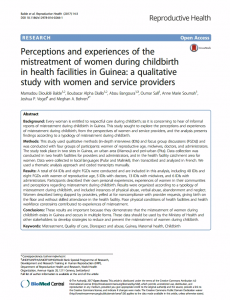
Background
Every woman is entitled to respectful care during childbirth; so it is concerning to hear of informal reports of mistreatment during childbirth in Guinea. This study sought to explore the perceptions and experiences of mistreatment during childbirth, from the perspectives of women and service providers, and the analysis presents findings according to a typology of mistreatment during childbirth.
Methods
This study used qualitative methods (in-depth interviews (IDIs) and focus group discussions (FGDs)) and was conducted with four groups of participants: women of reproductive age, midwives, doctors, and administrators. The study took place in two sites in Guinea, an urban area (Mamou) and peri-urban (Pita). Data collection was conducted in two health facilities for providers and administrators, and in the health facility catchment area for women. Data were collected in local languages (Pular and Malinké), then transcribed and analyzed in French. We used a thematic analysis approach and coded transcripts manually.
Results
A total of 64 IDIs and eight FGDs were conducted and are included in this analysis, including 40 IDIs and eight FGDs with women of reproductive age, 5 IDIs with doctors, 13 IDIs with midwives, and 6 IDIs with administrators. Participants described their own personal experiences, experiences of women in their communities and perceptions regarding mistreatment during childbirth. Results were organized according to a typology of mistreatment during childbirth, and included instances of physical abuse, verbal abuse, abandonment and neglect. Women described being slapped by providers, yelled at for noncompliance with provider requests, giving birth on the floor and without skilled attendance in the health facility. Poor physical conditions of health facilities and health workforce constraints contributed to experiences of mistreatment.
Conclusions
These results are important because they demonstrate that the mistreatment of women during childbirth exists in Guinea and occurs in multiple forms. These data should be used by the Ministry of Health and other stakeholders to develop strategies to reduce and prevent the mistreatment of women during childbirth.